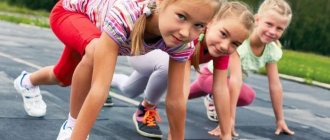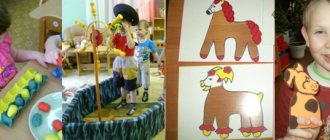Charging for children 5–6 years old
In older preschool age (5–6 years), the child’s cognitive and physical abilities actively develop. Daily exercise is no less important for a five-year-old than developmental classes in mathematics, reading, the environment, and other sciences offered to preschoolers. At this age, most sports sections are already available, but even visiting them does not negate the relevance of home physical education, and for those who do not play sports with professional trainers, exercises must be done with special care.
- What are the benefits of morning exercises for children 5–6 years old?
- What exercises should I offer a child at this age?
- How to interest your baby in an activity?
Let's figure it out together!
The benefits of morning exercises for preschoolers
Physical development
- Flexibility and plasticity;
- agility and coordination;
- strength and speed -
a well-chosen set of exercises promotes intensive development of physical performance, and also strengthens the cardiovascular, nervous and musculoskeletal systems. Agree, these arguments alone are enough to greet every new day with exercise.
Development of intellectual abilities
- Attention;
- memory;
- concentration -
In order to perform the exercises correctly, the child must demonstrate qualities that form mental activity. You can vary the methods of doing exercises: ask your child to repeat the exercises after you or give him verbal instructions. Of course, in the second case the task becomes more difficult, because the baby needs to figure out what exactly is required of him. But boys and girls 5–6 years old can do this task!
An outlet for emotions
- Jump and run;
- stretch your palms towards the sun;
- imagine yourself as a graceful cat or an active bunny -
morning exercises give a powerful charge of positive emotions, which makes it much easier to start the day in high spirits. You can use physical exercise to relieve the stress that has accumulated during the day. For example, diversify educational activities with outdoor games - this is also a good exercise that allows you to throw out emotions in an acceptable form.
Educational function
- Compliance with the regime;
- following instructions;
- overcoming laziness -
Children will not always perceive exercise with joy, but with a competent approach from adults, they develop their strong-willed qualities, learn diligence, and develop the habit of making efforts on themselves in order to achieve their goals.
Of course, your task, dear moms and dads, is to make sure that the moment of some coercion is minimal. And to do this, you need to offer your child interesting complexes, organized in a fun way.
How to do morning exercises: tips for parents
- If you have a choice between exercising at home or outside, always choose the latter.
- When exercising at home, do not forget to thoroughly ventilate the room before starting charging. The room should be clean and well lit.
- If you taught your child to do morning exercises from early childhood, doing exercises from the age of 2–3, or even earlier, then by the age of 5 the child can already perform the exercises independently. A beginner in this activity that is beneficial for children’s health needs your help. Do exercises with your child until it becomes a habit.
- You can compose sets of exercises yourself, having studied what movements are necessary for the harmonious physical development of a five-year-old, or you can use video lessons in which this work was done by professional children's trainers.
- Choose suitable music for morning exercises. Create several playlists: by changing them, you will add variety to your activities, which will help keep your child interested.
- Don't forget about such important components of exercise as warm-up and cool-down. They are needed to first set the body up for work (warm-up), and then return it to a calm state (cool-down).
- Control your child’s breathing while performing morning exercises. It should be smooth and deep. You must inhale through your nose (with your mouth closed), you can exhale through your mouth. At first, until you develop a habit, say out loud: “inhale,” “exhale.”
- At the age of 5–6 years, children already develop awareness and volition, but it is still not easy for them to concentrate on a serious activity for a long time. But if you offer exercises under the guise of a fun game, then exercise will turn from a duty into a favorite fun activity.
- Do not try, succumbing to sports zeal, to load your child with complex exercises. Exercise should give a surge of strength and energy, and not exhaust and tire.
- Charging time for children 5–6 years old should be 7–10 minutes.
Themed morning exercises for older preschoolers
"Gifts of Autumn"
On autumn days, an interesting option for morning exercises can be exercises accompanied by poetry. For the proposed exercises you will need a small ball.
| Words | Exercise | Qty |
| The harvest grew in the field, | Walking in place. Hands on the belt. Rocking the body from side to side | 30 s |
| Collect quickly. | ||
| The kids ran | Run in place. Arms are bent at the elbows and pressed to the body | 20 s |
| Collect ranetki. | Running with high knees | 5 s |
| We picked a lot of apples | IP: legs together. Hands with a ball below | 6 times |
| We stood on our toes. Hands raised. Pull the ball up | ||
| All the boxes were filled. | We lowered the handles down. Squatted down. | |
| Returned to IP | ||
| Picked onions and peas, | IP: we are on our knees. Hands with the ball are raised up. | 4 rubles each in each side |
| Our harvest is good | Alternately lean left/right | |
| They took out a round pumpkin, | IP: We stand straight. Feet together. Hands with the ball raised up | 6 times |
| Tilt down. We try to reach the floor with the ball. | ||
| Almost fell next to her. | We squat down. Hands down. | |
| Returned to IP | ||
| We picked tomatoes | IP: feet shoulder width apart. Hands with the ball extended forward | 4 rubles each in each side |
| They were scattered into buckets. | Bends alternately to the right/left leg | |
| And the pot-bellied zucchini, | IP: sitting on the floor, focusing on your arms laid back. Ball held between feet | 6–8 times |
| He fell slightly onto his side. | Raising and lowering legs at an angle of 30–45 degrees | |
| We collected watermelons | Sit on the floor with your legs bent at the knees (lotus position, or “Turkish”) | 8–10 times |
| They were thrown into the truck. | Throw the ball over your head and catch it | |
| And then with raspberries | Bring the ball to your face | |
| We blew away dust particles. | Blow on it, exhaling deeply through your mouth. | 4 times |
| We were going home | Jumping in place | 15 s |
| On a truck. | ||
| Open the gates | Calm walking in place | 30 s |
| The work is over. |
"Animal Charge"
The “animal” theme is fertile ground for exciting exercises with kids. You can perform movements to rhyming lines about animals, you can imitate graceful panthers, strong but clumsy bears or nimble little chickens. There is room for parental imagination to run wild! For example, you can do morning exercises using the following words:
| Words | Exercise | Qty |
| And kittens and chickens, | We stand straight. Feet together. Hands raised above head | 15 s |
| And lambs and puppies | Shake both hands | |
| They love exercise in the morning, | Marching in place | 30 s |
| To gain health. | ||
| The duck waves its beak | We stand straight. Feet shoulder width apart. Hands down, fingers reaching to the floor | 4 times |
| Repeat quickly, little one! | Head tilt forward/backward | |
| The cat turns his head | We stand straight. Feet together. Arms to the sides, palms tense | 4 times |
| You and I are not lagging behind. | Head tilt left/right | |
| The dog is stretching its paws, | We walk in circles on our toes. We pull our hands up | 30 s |
| He walks on tiptoes. | ||
| And the babies are chickens | We walk in circles on our heels. Hands on the belt | 30 s |
| They run on their heels. | ||
| And kittens and chickens, | Alternately stretch out both hands in front of you | 10 s |
| And lambs and puppies | Shake the brushes | |
| They stretch their legs, they stretch their wings, | We put our hands on our shoulders | |
| They are drawn towards the sun into the heavens. | Let's stand on our toes. Pull the handles up | |
| They stretch their legs, they stretch their wings, | Let's stand on our feet. We put our hands on our shoulders | Repeat 6 times |
| Drawn to the sun in the sky | Let's stand on our toes. Pull the handles up | |
| And then the animals | We stood up straight. Feet together. Arms extended forward. | 6 times |
| They pull their paws towards their paws. | Leaned forward. We reach out with our hands to our legs | |
| And when they get tired, | We stood up straight. Feet shoulder width apart. Hands on the belt | 6 times |
| The back is kneaded. | Bends back | |
| And then everyone jumps | We jump “feet together, feet apart”, clapping our hands above our heads | 15–20 s |
| And they kick their legs. | ||
| Everyone needs to rest | We stood up straight. Hands along the body | |
| Exhale - inhale. | We reached up. Hands above your head - inhale. Hands down - exhale | 15–20 s |
| We can continue | Calm walking in place | 20 s |
| Walk in a circle. | ||
| All! Stopped! | Curtsyed | |
| Bowed to each other |
Friends! We will be glad if our advice and sets of exercises help you introduce your baby to morning exercises. Let your children grow up healthy and happy!
Happy parenting to you. See you again!
What mistakes do parents make when doing exercises for their kids?
Infant gymnastics is a very simple activity, however, even in it there are certain rules that must be followed:
- If you see that the exercise is clearly not going according to plan, it means the child is not yet ready for it. Try again in a few days.
- Do not do gymnastics if the baby has just eaten or wants to sleep. All exercises should be done only when the baby is ready for physical activity.
- Watch the signals he gives. If the child is capricious and does not want to exercise, end the training.
- Some parents consider walkers the best exercise for their legs. This is not true - this device is rather harmful to the baby. In a walker, he is in a semi-suspended state, which does not contribute to the development of correct walking skills.
And the most important advice: before introducing each new exercise into the “training program” and with any questions that arise, consult your pediatrician!
Other types of children's gymnastics
So you have become acquainted with the most reliable and proven methods. However, there are several other types of gymnastics that parents may be familiar with: baby yoga, dynamic gymnastics and mom yoga.
In the first case, we are talking about the manual practice of getting rid of possible birth injuries in the first two weeks after the birth of a child, which is carried out only by a highly qualified specialist. The second is a set of acrobatic exercises aimed at correcting muscle tone and developing coordination and the vestibular apparatus; training takes place in special classes with an instructor. In the third case, we are talking about mother’s yoga classes in the presence of the baby with a small number of asanas, in which the baby can participate without experiencing any physical activity, but simply maintaining contact with the mother.
Thus, all these types of gymnastics cannot be done at home without preparation. If you are interested in these types of physical activity and are determined to try them, first consult with a pediatrician, neurologist and orthopedic surgeon, weigh the pros and cons, and take training from a certified instructor.
Let's sum it up
Morning exercises have a beneficial effect on a growing body. It gives impetus to harmonious physical development. To ensure that gymnastics only brings benefits, consider the child’s age, health and desire. Turn it into a tradition, an entertaining game and do it regularly. Do not overtire your child, let gymnastics fulfill its main task: it helps the body wake up and gives a charge of vigor. Then you will gradually teach your son or daughter to exercise. In the future, this will help them quickly adapt to sports loads and fall in love with training.
Basic principles of aqua gymnastics
- Comfortable water temperature in the first lessons is 37 - 37.5 degrees, with a decrease in it by 3 degrees until the end of the first month of swimming, and another 2 degrees in the third. For those who are bolder: please remember that the temperature should not fall below 28 degrees - in this case we are talking about hardening.
- The air temperature in the bathroom is 20 - 22 degrees, the door is open. Classes are held 40–60 minutes after feeding and 30 minutes before it.
- Duration of classes - 5 - 20 minutes.
- Water should be without additives (potassium permanganate, essential oils, herbal decoctions, salt), since baths with these additives are therapeutic and are designed for a lying baby, and aqua gymnastics is a set of active exercises with a fairly intense load on the muscles, respiratory, and cardiovascular systems.
- During exercises in water, the baby's ears may become submerged in water; after exercise, do not forget to dry them.
- The duration of classes in water for babies under 4 months in addition to a general massage is about 5 minutes, for older children - up to 10 minutes.
- As an independent type of exercise, aqua gymnastics is carried out for 15 – 20 minutes.
- Contraindications are: open umbilical wound, skin diseases, poor health and mood of the child, acute respiratory viral and other infections in the active phase (exacerbations), acute period of encephalopathy, rapid increase in intracranial hypertension, convulsions, extreme prematurity of children (rapid cooling) and general contraindications related to the purpose of gymnastics and massage.
Aqua gymnastics technique
You should start teaching your baby to swim slowly and calmly. At first, we try to develop swimming reflexes, which begin to fade after birth if the child does not swim. At first, we hold the baby with both hands: one hand supports the head and upper back, and the other supports the chest area (both on the back and on the stomach). Make sure that the child's body is in the water, maintaining a horizontal position.
Classes begin with sliding on the surface of the water (along the bath, figure eight) and rocking. Your baby's ears may be in the water; when swimming on your chest, support your chin to prevent water from getting into your mouth. When you notice the appearance of rowing movements, you can remove one hand. Now you only support the baby's head. This creates conditions for free movement of arms and legs when swimming in a position on the stomach and back.
If the baby enjoys exercising in the water, you can begin to teach him to hold his breath: pour water on the baby’s head and face with water taken from the bath with your hand. The baby will close his eyes and hold his breath for two to three seconds. Repeat 3-4 times at each lesson.
When the child is already sufficiently trained, learns to hold his breath and masters the skill of rowing with his hands, you can teach the baby to swim independently. But this is a topic for another conversation, but for now your main goal is to simply make friends with water.
The set of exercises we offer is designed to be performed independently at home.
- Backstroke. In this case, the adult supports the back of the child’s head with one hand, and the other hand is under his back. Linear, zigzag movements are made back and forth, with the legs pushing away from the edges of the bath.
- Swimming on your stomach. Until the child has learned to hold his head well, his head and neck are supported on both sides. Older children are supported in a prone position with one hand under the chin (like a “bucket”), and the body is held with the other hand.
- Sidestroke. The child's head and torso are placed on the forearm of one adult's hand, and the baby's hand is held with the other hand.
- Older children can walk and bounce in the bathtub with the support of an adult under their arms.
Don’t forget that the most important thing in aquagymnastics (like any other) is the combination of benefit and pleasure, so don’t try to do it “right,” listen to your baby’s wishes, improvise and just enjoy the minutes of such pleasant communication. If you are not overly tense, your movements will become soft and confident, the baby will not show anxiety, and the exercises will bring only positive emotions to both of you.
What exercises are needed for babies from 9 months to one year?
Over the previous months, the child learned to sit up and crawl on his belly. Now he is mastering crawling on all fours and confidently rises to his feet, holding onto a support. Very soon the baby will reach a fundamentally new stage of development - it will begin to walk, so a set of exercises for children of this age is mostly aimed at developing the skills of getting up and walking. Also during this period, the child begins to understand speech, so accompany the exercises with simple commands and praise the little athlete for the success achieved.
Exercise to train balancing skills
Place your child facing you and grab him under your elbows with your hands. Slowly lower your hands down - leaning on them, the baby will sit down a little, then start raising your hands to the starting position so that he stands up again, repeat several times. Such exercises are good for the back, stomach and legs, and also help the baby learn to sit and stand more confidently.
Exercise to improve coordination of movements
Place your child's back to you. Gently but firmly hug him at the level of his knees and hips - so that he cannot bend his knees and get on all fours. To interest your baby, place a toy in front of him: when he bends down and picks it up, take it away and return it, repeat several times. This exercise is aimed at developing coordination of movements and also strengthens the abdominal and back muscles.
An exercise to help your baby take his first steps
Place the child facing you and take him by the hands. Pull him towards you a little so that he begins to lose his balance. If the baby is not yet ready to walk, he will kneel down; if he is ready, he will take a step forward. Continue pulling towards yourself so that the first step is followed by others, repeat the passage a couple of times. This activity is one of the important developmental exercises for a baby, preparing him for independent walking and helping to strengthen many muscle groups.
Exercise to develop walking skills
Do you have a children's wheelchair? Place the child on his feet and let him grab the handle of the gurney. Push her forward a little so that he takes the first step, pushes the gurney forward a little and follows her. When insuring your baby, let him walk some distance behind the moving cart. This exercise develops walking skills and prepares the child for the first steps without support.
Exercise technique
We hold the child’s legs from above, press them against the ball, and the other hand fixes the back. We make soft, rocking movements: back and forth, left and right, circular movements left and right. There is no need to tilt the child forward very much, more emphasis is placed towards the legs. As the child gets used to the ball, the amplitude can be increased. You can also make movements in two planes - back and forth and up and down at the same time. The same movements are performed on the back as on the stomach; they should begin no earlier than 3 months: back and forth, left and right, circular movements in one direction and the other.
- Baby on tummy. We place our hands on the baby's back and lightly press him against the ball. You can hold the baby by the back with your right hand, and use your left hand to fix the left leg in the area of the knee joint. We begin to slowly rock the baby forward, backward, in a circle, so that there is a slight vibration.
- In the same position, rock the baby towards you and away from you, with slight vibration if the baby is already holding his head.
- Baby on the back. We hold it with our hands by the stomach and in the shin area, or you can fix the tummy with your right hand, and the left leg with your left. Slowly, when swinging the ball towards us, we bend the baby’s legs at the knee joints, and when moving the ball away from us, we straighten it. Gently rock the child while lying on his back in a head down position. It’s good if the baby straightens his arms at the same time, this reduces the tone of the flexor muscles. Now we try to perform the same movement, first only with the right leg, then only with the left leg.
- The baby is on his tummy again. We hold his hands and rock him back and forth. Gradually raise the arms extended forward so that the baby lifts his chest away from the ball.
- In the same position, we hold the baby in the lumbar region with our right hand, and with our left we try to put him in the “frog pose”, spreading his knees wide. In this position, we rock forward and backward, creating vibration. This is not only relaxing, but also very beneficial for the development of the hip joints.
While practicing on the ball, talk to your baby, praise him, sing songs or tell jokes. If your child doesn’t like something or is already tired, stop classes and continue another time. The time for practicing on the ball is not strictly regulated. If you and your child enjoy it, do as much as you want throughout the day.
Exercises for younger students
The following exercises will diversify the morning exercises of an elementary school student.
- "Jumping out." Feet shoulder width apart. Hands on the belt. Let's squat. We jump out. At the same time, we raise our hands up. Repeat 10-15 times.
- Plank. Focus on your hands and toes. We keep a straight line, the pelvis does not bend. You can start with 10-15 seconds, gradually increasing the time to 30 seconds. Repeat 5-10 times.
- "Martin". From a straight position, we raise our legs and spread our arms to the sides. The leg should be straight and taut. We change the leg. Repeat 5-10 times.






